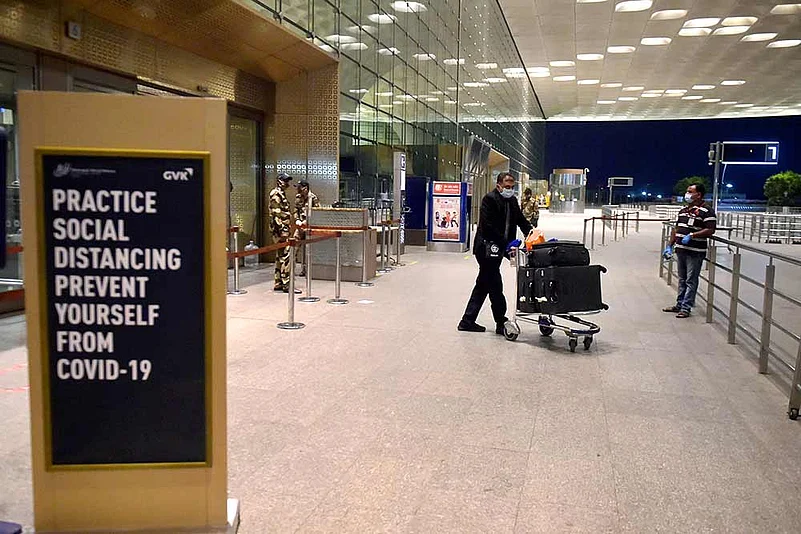Union Minister for Civil Aviation Hardeep Singh Puri on Wednesday announced through his Twitter handle that domestic flights will resume from May 25 in a “calibrated manner”, and all airports and air carriers are being told to prepare for operations.
On Thursday, the Ministry released a detailed guideline for airport operators, passengers, aviation companies and other stakeholders to follow, to avoid the spread of COVID-19 infections.
These guidelines are silent on several mandatory provisions issued by the Ministry of Health and Family Welfare. For instance, the MoCA emphasises on maintaining social distancing at the airport, however, it does not mention how it will be ensured inside the aircraft.
Aviation professionals believe that the decision is in favour of airline companies. Independent experts also believe that the decision has been taken under pressure from private operators, as the government hasn’t given any bailout package to the aviation sector.
“Ministry of Home Affairs, while issuing a guideline on May 17 for lockdown 4, prohibited all domestic and international air travel till May 31. Just four days after that, the aviation minister has announced that domestic operations will begin from May 25. It seems that the private operators have pressurised the government for that,” an aviation professional, requesting anonymity, said.
However, the bigger question is how flights will operate when various services, on which the success of air operation depends, are still restricted.
Experts believe that flying will be subject to multiple restrictions and until the complete eco-system is back on track, airlines will find it difficult to operate. Here is why:
Commuting between the airport and home: There are some states, like Punjab, which have enforced a strict curfew on the movement of people. There are others, like Delhi, which have relaxed norms. Flight resumption will heavily depend on local relaxation on people’s movement so that passengers will not remain stranded at the airport. The Ministry’s guideline has several instructions for airport taxi operators. “However, this is again subject to local restrictions. One can go from the airport to home but how will a person come to the airport from home?” D Sudhakar Reddy, President, Air Passengers Association of India, asked.
Flights between cities in red zones: Will the government allow flights among cities in red zones? Most of the big cities like Mumbai, Delhi, Kolkata, Ahmedabad, Surat, Vadodara, Chennai etc are marked as red zones. The MoCA’s guideline says that limited flights (one-third) will begin from May 25 and “further augmentation of flights will be done in a calibrated manner.” “Once the government announces the schedule, it will become clear whether the operations will be resumed from all cities or only within cities in green zones. That’s why the Minister has said that the resumption will happen in a calibrated manner,” Jitendra Bhargava, an aviation expert, says.
Social distancing inside the aircraft: Interestingly, the MoCA’s guideline is completely silent on maintaining a physical distance of one meter, a condition the Union Health Ministry has enforced in public places. Aviation experts have clarified that social distancing is financially not viable within the aircraft and all measures have to be taken beforehand to ensure that an infected person does not board the flight. It was earlier reported that the last three rows would be left vacant for any person who would develop symptoms of sickness. However, the MoCA’s guideline doesn’t have any such provision for aircraft operators. Having said that, in many asymptomatic cases, even the infected person does not know that he is positive for coronavirus. The ICMR itself admits that over 80 per cent cases are asymptomatic. How many people will take such a risk and fly unless there is a high emergency?
Age limitation for fliers: The MHA guideline says that persons above 65 years of age, person with co-morbidities, pregnant women and children below the age of 10 years shall stay at home, except for essential and health purpose. The MoCA’s guideline says that vulnerable persons, such as very elderly, pregnant ladies, passengers with health issues are advised to avoid air travel. However, it allows children to travel with an attendant.
Night Curfew restricts movement: The curfew on movement between 7 PM to 7 AM enforces further restrictions, which means that flights have to be operated during the day time, leaving a huge time gap for passengers to reach home before time restrictions kick-in. Further, MHA has asked states to allow all essential services but the decision on non-essentials shall be taken based on local conditions. No such instruction is there in the Aviation ministry’s guideline.
Closure of hotels and restaurants: The MHA has asked all the states to keep hotels, restaurants and other hospitality services suspended till May 31. People planning to travel due to urgent business purposes will find it difficult to get accommodation for even a short stay. This will discourage a lot of people to plan their travels.
Health Ministry guidelines on quarantining suspects: What if a flyer tests positive a few days after taking the flight? Will all the co-passengers quarantine themselves? Aviation Ministry guideline has no clarity for such situations. If this is so, it violates the Ministry of Health and Family Welfare (MoHFW) norms and also defeats the whole purpose of lockdown. Keeping all these issues in mind, it will be interesting to see how aviation ministry resumes air operations while respecting the norms of MoHFW and MHA.
Meanwhile, the Federation of Chambers of Commerce and Industry (FICCI) has welcomed the government's decision, saying it will help the aviation industry begin the process of recovery.
"We welcome GoI’s decision to resume domestic flights from May 25. Resumption of flights, while adhering to all health & safety rules, will help the industry to begin the process of recovery from the massive blow dealt by COVID," Mr Anand Stanley, Chair, FICCI Aviation Committee, said.
















